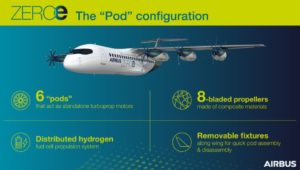Airbus has unveiled plans to revolutionise travel air travel and cut emissions through attaching self-contained pods to the underside of aircraft wings.
The design features three hydrogen fuel cell pods attached to the underside of each of the aircraft’s wings. Each individual pod contains hydrogen and air which are combined to generate electric current. The ‘pod’ units are designed to be detachable – they can be clipped on and off after a flight to speed up any maintenance that may be required.
Energy is created through hydrogen and oxygen with water the only waste product produced. The current powers the electric motor, causing the motor shaft to rotate and turning the eight-bladed propeller. Airbus said the propellers were shaped to provide added thrust during the takeoff and climb-out flight phases.
The hydrogen ‘pods’ are among a number of options being considered by Airbus engineers as they pursue low-carbon alternatives to traditional aviation fuel. The manufacturer unveiled a trio of ZEROe concept aircraft which were also powered by the fuel in September.
Configuration could be scaled up for commercial aircraft
“The ‘pod’ configuration is essentially a distributed fuel cell propulsion system that delivers thrust to the aircraft via six propulsors arranged along the wing,” explains Matthieu Thomas, ZEROe Aircraft Lead Architect. “Hydrogen fuel cells have very different design considerations, so we knew we had to come up with a unique approach.”
Glenn Llewellyn, VP of Zero-Emission Aircraft added: ‘This “pod” configuration is a great starting point to nurture further inquiry into how we can scale up hydrogen technology to commercial aircraft. This is one option, but many more will be conceptualised before we make a final selection, a decision that is expected by 2025.”
Airbus is conducting studies to determine how the pod configuration can be scaled and used on commercial aircraft.

